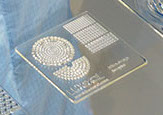jasu
1
Transparency can be used to create great models that allow a look inside at deeper structure while also showing the surface of the surrounding. We would like to produce a transparent model of a cell or a protein with internal structures highlighted. What I’m not sure about is whether 3D printing is up to the job.
This excellent model of hemoglobin, the red color of blood, does a great job and has very good transparency. Alas, it’s not 3D printed but a mold.
I doubt how transparent many materials really are. This dragon, for example, blocks most of the metal behind from view. This thread has pictures of allegedly transparent filaments that are at best partly translucent. Related threads on 3D Hubs recommend clear XT from colorfabb but this sample print is very milky and hard lets anything through (full thread).
Formlabs appears to have a clear resin that may be an option (thread). T-Glase also looks promising but again some models on the Taulman company page appear more white than transparent.
What’s the closest to glass-like transparency?
What kind of treatment do some of these materials need to become more transparent?
ferkan
2
I’ve got experience with the clear resin by Formlabs. In my opinion that is quite transparent, especially with some post-processing (xtc-3d). If you want to achieve even more transparency, you might look into a company called Luxexcel (based in Holland). They’re specialised in 3d printing optics with very high transparency.
2 Likes
Any FDM material by nature can’t achieve any sort of usable transparency while still maintaining any sort of thickness. You might have success with 1 or 2 layers/1 perimeter, but beyond that the lines drawn with the material, which is how it prints, will block too much light.
Your best bet is some form of SLA/DLP resin. The clear resin by Formlabs as mentioned is fairly transparent. I’m not too sure of what else would be, but my instincts tell me SLA/DLP would have much better luck with transparency in general.
1 Like
Hi,
I have printed with HD Glass from Form Futura, which gave good clear results. Believe good transparency is obtained with low infill and temperature. There are photos of swirly glass upon my hub which show how clear it can be, those prints were done with a high 40% infill but Form did state it’s the closest that they had seen to totally clear, check out their description in the link above.
1 Like
jasu
5
Hi Ferkan, excellent tips. This clear resin model from the Formlabs website does indeed look very transparent. Luxecel even prints glasses, so their prints must be transparent. A sample photo (attached) also shows that. I have to contact them about pricing though to see whether that’s within range.

jasu
6
Thanks for the reply. I checked out your swirly glass. Nice. It shows the side effects of the printing by layer that can reduce transparency if the model is not as thin as your glass. If we printed a human cell model, we would have to fill as little as possible to be able to see through the membrane.

It was printed with slic3r’s default perimeter setting of 3 but there is also the Spiral vase check-box which would produce a single walled print.
jasu
8
Hi Karl, thanks for your insight. I agree, filament deposition probably invariably creates a boundary between layers that interferes with light, i.e. transparency. So, a liquid hardening method like the one from formlabs is much better positioned to print more translucent materials.